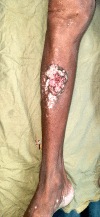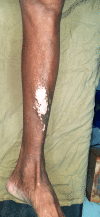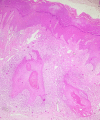Hypertrophic Lichen Planus: A Precursor Lesion for Squamous Cell Carcinoma
- PMID: 38571860
- PMCID: PMC10987401
- DOI: 10.7759/cureus.55450
Hypertrophic Lichen Planus: A Precursor Lesion for Squamous Cell Carcinoma
Abstract
Squamous cell carcinoma (SCC) is the second most common malignant tumor of the skin. This case report aims to report a case of cutaneous squamous cell carcinoma in an elderly male presenting with a non-healing ulceroproliferative growth on the shin of the right lower limb and a hypopigmented patch on the shin of the left lower limb. The significant feature of this case is that in the shin of the left lower limb, SCC appears in the background of chronic hypertrophic lichen planus (HLP) but in the right lower limb, there is no evidence of a background hypertrophic lichen planus. There are only a few similar cases reported so far in the literature showing long-standing hypertrophic lichen planus as a risk factor for the development of cutaneous squamous cell carcinoma. This case illustrates that chronic hypertrophic lichen planus should be considered as a potential precursor lesion for SCC. Regular screening is essential for early detection, enabling timely intervention for improving patient outcomes.
Keywords: cutaneous squamous cell carcinoma; hypertrophic lichen planus; malignant transformation; non-healing ulcer; scc precursor; scc screening.
Copyright © 2024, M et al.
Conflict of interest statement
The authors have declared that no competing interests exist.
Figures




Similar articles
-
Giant Squamous Cell Carcinoma on Chronic Lichen Planus on the Ankle - A Case Report and Short Literature Review.Open Access Maced J Med Sci. 2019 Aug 19;7(18):3061-3063. doi: 10.3889/oamjms.2019.553. eCollection 2019 Sep 30. Open Access Maced J Med Sci. 2019. PMID: 31850123 Free PMC article.
-
Squamous cell carcinoma arising in hypertrophic lichen planus.BMJ Case Rep. 2018 Jul 11;2018:bcr2017224044. doi: 10.1136/bcr-2017-224044. BMJ Case Rep. 2018. PMID: 30002207 Free PMC article.
-
Squamous Cell Carcinoma Arising in Hypertrophic Lichen Planus: A Review and Analysis of 38 Cases.Dermatol Surg. 2015 Dec;41(12):1411-8. doi: 10.1097/DSS.0000000000000565. Dermatol Surg. 2015. PMID: 26551772 Review.
-
PD-1 Inhibitor Induced Hypertrophic Lichen Planus: A Case Report.Drugs R D. 2024 Jun;24(2):353-357. doi: 10.1007/s40268-024-00461-x. Epub 2024 Jun 15. Drugs R D. 2024. PMID: 38877280 Free PMC article.
-
Hypertrophic Lichen Planus and Hypertrophic Skin Lesions Associated with Histological Lichenoid Infiltrate: A Case Report and Literature Review.Dermatopathology (Basel). 2025 Feb 25;12(1):8. doi: 10.3390/dermatopathology12010008. Dermatopathology (Basel). 2025. PMID: 40136318 Free PMC article. Review.
References
-
- Global Burden of Disease Collaborative Network. [ Feb; 2024 ]. 2020. https://vizhub.healthdata.org/gbd-results/ https://vizhub.healthdata.org/gbd-results/
-
- Analysis of the p53 gene in human precancerous actinic keratosis lesions and squamous cell cancers. Nelson MA, Einspahr JG, Alberts DS, et al. https://pubmed.ncbi.nlm.nih.gov/7923098/ Cancer Lett. 1994;85:23–29. - PubMed
-
- Actinic keratoses. Natural history and risk of malignant transformation in the Veterans Affairs Topical Tretinoin Chemoprevention Trial. Criscione VD, Weinstock MA, Naylor MF, Luque C, Eide MJ, Bingham SF. Cancer. 2009;115:2523–2530. - PubMed
-
- Malignant transformation of solar keratoses to squamous cell carcinoma. Marks R, Rennie G, Selwood TS. Lancet. 1988;1:795–797. - PubMed
Publication types
LinkOut - more resources
Full Text Sources
Research Materials
Miscellaneous
